Occasionally, we like to host webinars and do a deep dive on a particular process or issue facing immigrants going through the immigration process.
Below is the transcript from our most recent webinar with Immigration Attorney Jacob Sapochnick that covers just about everything you need to know about going through the green card application process.
The green card application process can be pretty complex and overwhelming for applicants, which is why we’re on a mission to make it as easy to understand as possible. In this webinar, we explain the entire process and break down each step of the green card application process so that it’s easy to understand. If you have any questions about the green card process, please feel free to chat with us by clicking on the chat icon in the lower right corner of your browser window. Or, email us at support@simplecitizen.com.
What is SimpleCitizen?
SimpleCitizen is a technology company that has simplified the immigration process. Like “TurboTax for Immigration”. Our software has helped thousands of people go successfully through the family immigration process. From applying for an initial green card, to removing conditions, green card renewals, and even citizenship. Our services make it simple for applicants to fill out their own application with the guidance and expertise of a licensed immigration attorney helping every step along the way.
To contact SimpleCitizen, click here.
Who is Jacob Sapochnick?
The San Diego Immigration Law Offices of Jacob J. Sapochnick is a unique law firm committed exclusively to the areas of immigration and citizenship law. They have big firm expertise in these specialties, but strive to deliver personalized client services at a more economical cost. The practice is a multi-lingual firm and is able to serve clients in a variety of foreign languages: Spanish, Swedish, Mandarin, Danish, Hebrew, French and Russian.
To contact The Law Offices of Jacob Sapochnick, click here.
Topics covered in the webinar:
Green Card Application Family Preferences
Green Card Eligibility
What is Concurrent Filing?
What is Lawful Permanent Residency?
Green Card Application USCIS Forms
Putting the Application Together
Application Fees
SimpleCitizen’s Immigration Attorney Review
Mailing the Application
USCIS Case Status Checker
Webinar Questions & Answers
How to Apply for a Green Card Webinar
Here is a video recording of the webinar.
Followed by a transcript filled with helpful information and links.
Green Card Webinar Transcript:
Introductions
Matt: Hi everyone, thanks for joining us today. We’re going to get started. We are here at SimpleCitizen headquarters in Salt Lake City, Utah and today we are going to be talking about how to get a green card and we will be going back and forth between video and the slide deck. Okay my name is Matthew Gale and I am the VP of the community here at SimpleCitizen and I am here with Jacob Sapochnick, who is a renowned immigration attorney based out in San Diego.
Jacob: Can you hear me?
Matt: I can hear you Jacob.
Jacob: Perfect.
Matt: And so the way I am thinking this will work is we can go through the slide and feel free to interject in anytime, does that sounds good?
Jacob: Yeah, excellent.
Matt: Okay, you want to give a couple of minute introduction?
Jacob: Sure, so I am an immigration attorney based in San Diego, California. We are a full service law firm working with the all aspects of immigration law and we are working closely with SimpleCitizen to make sure that the software is always being improved and we make sure that the customers that are using the system are getting the best service with the least mistakes. Right now immigration services have been very very tough and there are a lot of issues – people are facing delays and we want to make sure that people understand what they have to do and how to do it and what is going to happen next. So we are excited to dive right in.
Matt: Awesome, thanks Jacob. So, like I said I am Matthew Gale and I am the VP of Community here at the SimpleCitizen, so let’s get started. So here is Jacob’s website and you can see on his website, it’s H1b.biz, has a lot of great resources, maybe Jacob just for a couple of seconds, you can talk about all the resources that you have on your website?
Jacob: Sure, so you know we have a lot of information, so we have in the services part, you can see all the different things that we do and you can see a lot of articles that explain that, we also have a podcast called Ask an Immigration lawyer” where people can actually post a question and we will answer them on video and on audio. We try to update the processing times of different resources and of course we have a lot of videos. We have one of the largest video libraries out there, so we tend to post video every week about different changes and about different topics in immigration law and also there is a link to our different apps that we have on iTunes as well as the book that I have written, it is on Amazon, so if you scroll through the website, there is a lot of resources up from family immigration to business immigration, to start-up immigration so we try to keep up with updates and put up more and more content on our website.
Matt: Thanks Jacob, okay here is our website, SimpleCitizen.com, so we are a self-service immigration website, sort of like TurboTax” but for immigration paperwork, we do green cards, green card renewal, citizenship and several different visas. On our website, we also have a blog where we have lots of content. We will answer different questions that can help you through the immigration process and getting your F1 student visa or getting whatever visa you are applying for then getting your green card, renewing that green card, and removing the conditions, and eventually apply for citizenship. So that website is learn.simplecitizen.com or you can click on the Learning Center in the menu.
Matt: So first of all let’s talk about who is eligible for lawful permanent residency or who is eligible to be a green card holder? And Jacob like I said earlier feel free to interject at any moment.
Jacob: Of course.
Family Preferences
Matt: So first is you can immigrate to the United States through family.
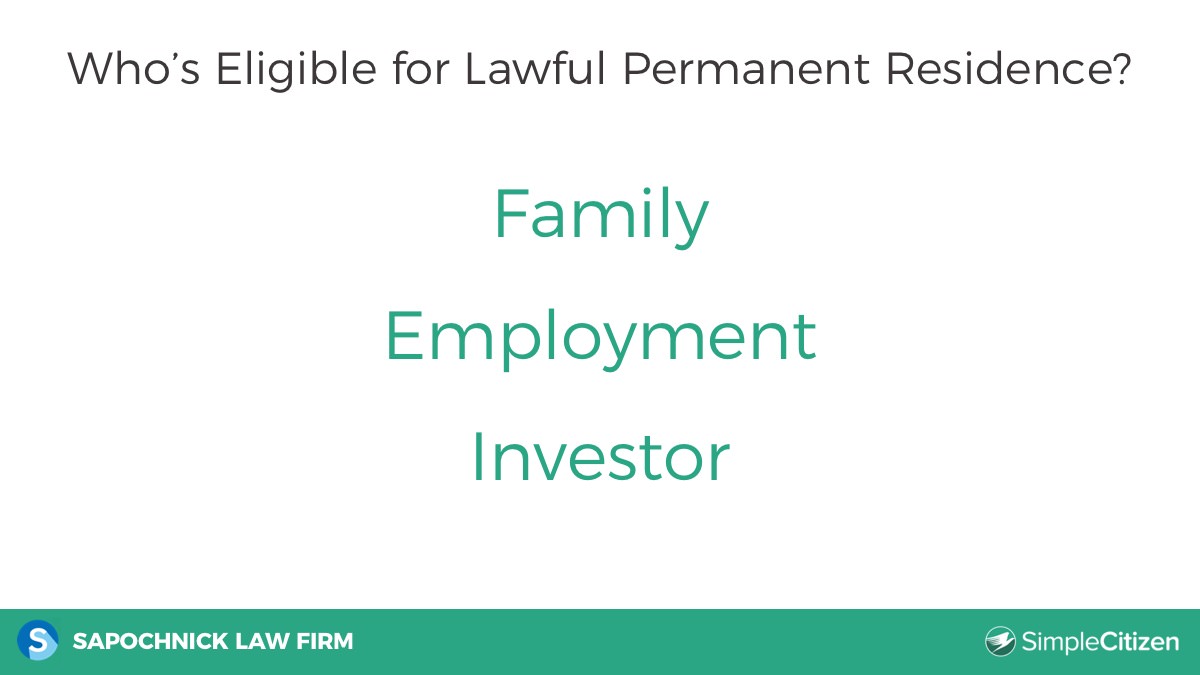
Matt: This is mostly immediate family relatives like the spouse, a parent, a child and then a sibling, we will talk about the difference between those categories here in a minute. The second category through which you can immigrate to the United State or reside here permanently is through employment, you have to have an employer who is willing to sponsor you and you have to go through a process in order to eventually get the green card and then the third main option is through investment. So you can invest around half a million dollars and you can eventually get a green card. There are some other categories like victim of a crime or refugee or asylum but today we are mostly going to talk about family immigration and we will talk a little bit about employment immigration.
Jacob: And you know there is another option that is available through the green card lottery which is still available till today, I mean they are talking about cancelling it but we still have the visa lottery which is separate categories for people who can immigrate but we are not focusing on that today.
Matt: But that is an option out there for anyone interested and yes we will do Q&A and we will be happy to answer questions on any of this category, we are just going to focus the slide and the presentation mostly on family immigration.
Green Card Eligibility Quiz
Are you eligible to apply for a Green Card?
Are you currently living in the United States?
Have you lived in the US for more than 3 months?
Did you enter the United States with an active visa or green card?
Are you married to a US citizen?
Do you have an immediate family member that is a U.S. Citizen or is a Green Card holder?

Analyzing Eligibility
We're sorry.
You are probably not eligible to apply.
If you would like to apply for a Green Card, instead of a Renewal, we can help you.
Congratulations!
You are eligible to apply for a Green Card with SimpleCitizen!
What is Concurrent Filing?
Matt: Okay, we are first going to talk about concurrent filing.
Matt: Concurrent filing means you can immigrate to the United State through immediate family relationship like a spouse, a parent or a child who is over 21 who can sponsor that parent. And so what that means is if you are living in the United States currently or if you have come here to visit and you have married, or you are visiting a child here who is over 21 or you are visiting a parent and you are under 21 and not married, then you can file all of your paperwork immediately. So that means you don’t have to file the initial petition which is the form I-130 which we will talk about here in a minute, you can file that petition along with all of the other paperwork at the exact same time. And so the process is much quicker for those immediate categories and there is also some employment based petitions that if the visa number is immediately available which means you can file concurrently.
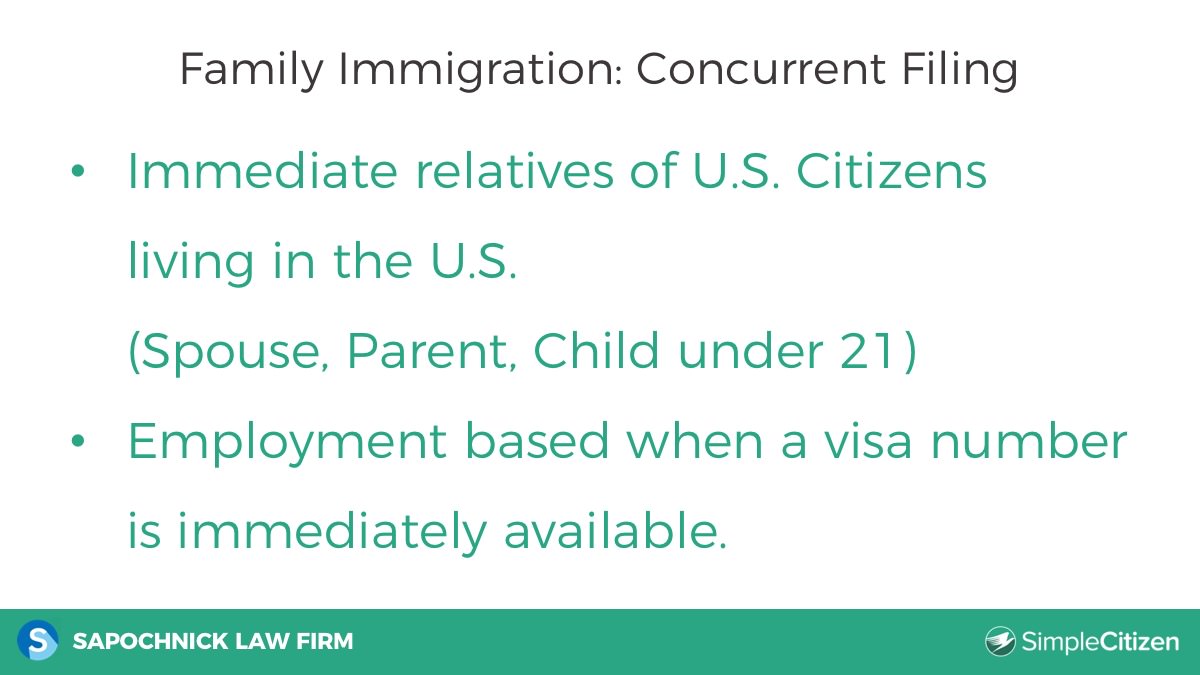
Jacob: Right, and I think distinction that we are trying to make here is that we are also talking about people that are currently inside the US. Those are going to be doing what is called the adjustment of status as opposed to the people that are not here and so all these people that Matt have mentioned are able to file currently are able to file concurrently because they are inside the US and they are going to be doing adjustment of status.
Matt: If you are outside the US you have to go through another process which is called the consular processing which we will talk about a little bit here in the future. So here are the different categories for family immigration, so we first talked about spouse, a minor child who is unmarried and a parent which those are the first category which you can file everything immediately if you are in the United State, if you are out of the United States, everything is processed pretty quickly as well but if you don’t fall on one of those categories, then you will fall on one of these categories. The first is F1 which is unmarried sons and daughters of a US citizen who is over 21. And you can see the processing time for that is about 6 years, so that means you will file the initial petition which is the I-130 and it takes 6 years for the I-130 to be approved and then you can go through the rest of the process to immigrate permanently. The second category is F2A which is the spouses and children of permanent residence and this currently is taking about 15 months and so if you are out of the country and you file the I-130 and then after 15 months you are able to go through the rest of the process or if you are in the country and you have a valid visa, you can wait those 15 months and then like Jacob said you can do it in an application. We also have the F2B category which is unmarried sons and daughters who are 21 years of age or older of permanent residents and that takes 6.5 years currently and you have F3, which is married sons and daughters of US citizens and that is like a 12 years and then you have F4 which are brothers and sisters of US citizens which takes about 13 years currently. Do you have anything to add here Jacob?
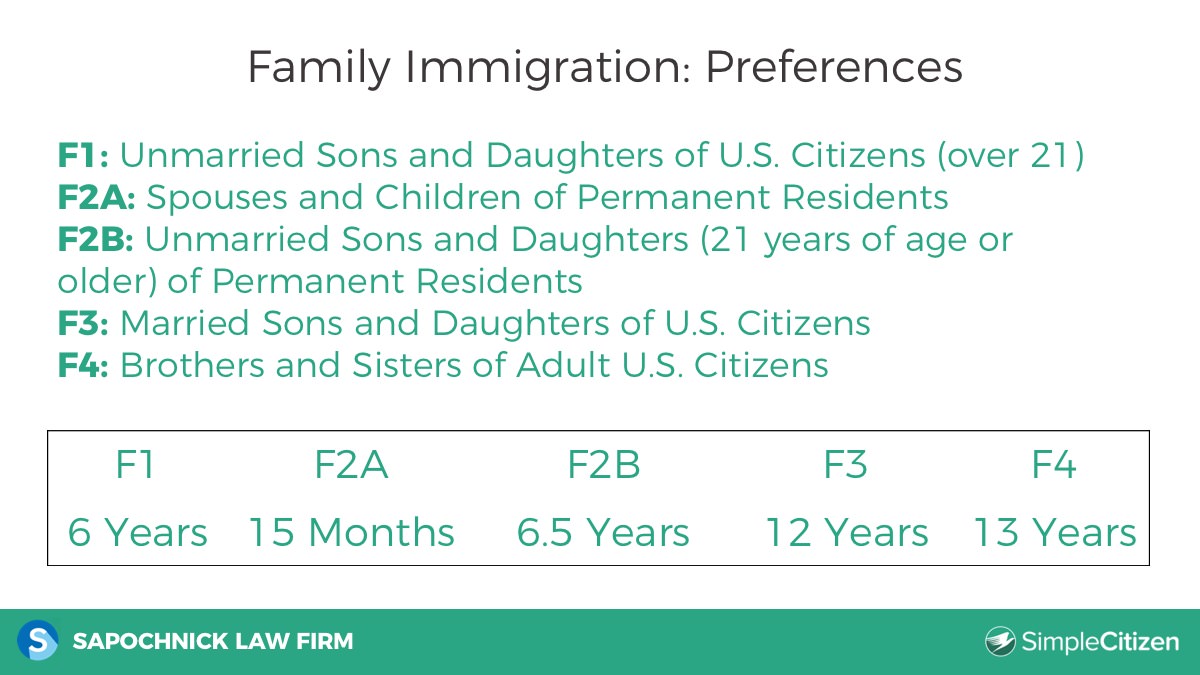
Jacob: Right, so one of the things that people are concerned right now is that some of the proposals they may want to eliminate something like category F4 which is basically a brothers and sisters and also people that are concerned about they take so long to file for a sibling, 13 years and up in most countries and sometimes in you know Mexicans and Philippians, it is even more than 20 years. They don’t start to process because it is going to take too long, we always recommend just do it now and by the time you think about it, it is already five years past, six years past, it is really important to do so and also people that are category F2B, there is a lot of consideration whether they should get married or not because the processing time will take longer if they didn’t marry. So those are considerations people have and they should be aware of as they take those steps, which are normal steps in life. They can affect your immigration process long term.
What is Lawful Permanent Residency?
Matt: Great thanks Jacob, okay so what exactly is lawful permanent residency for anyone who doesn’t know what exactly that means and what the benefits are, or a green card holder or non-US citizens who can permanently reside in the US and some of the benefits of being a green card holder include, work authorization without restrictions. So you get when you filed, it takes about 3-4 months to get an EAD card, you can work with that card and once you get it, then once you get the green card, you can work with a green card without restrictions. You also have the right to own property, you have the ability to apply for financial assistance for education and you can also be in the armed forces, and you are eligible for citizenship.
Jacob: One thing I want to add is that you know people when they become green card holders, some people don’t understand that a green card is not a permanent right to have it which means that while you can live here for ten years at a time and renew it, if you commit certain crimes, if you abandon your US residency and you leave for a while and come back you may lose the green card. And so the green card while it is permanent, you don’t have to get a visa, you can renew it every 10 years, there are something that you may do that may jeopardize your green card and may cause you to lose it. If you lose your green card, you may end up being deported or barred from coming back to the US. Therefore, we also tell people once you have a green card for five years in minimum, consider becoming a US citizen because once you are a citizen it is almost impossible to lose it.
How to apply for Lawful Permanent Residency?
Matt: Great thanks Jacob. So what exactly does the process look like to apply for a green card? First you have the USCIS forms, so these are all of the forms required to submit the paper work and to apply for the certain status you are applying for. So we are mostly going to talk about the main forms which we mentioned a little bit before form I-130 and the form I-485 and we will talk about some of the supporting forms like the form I-765 which is work authorization and form I-131 which is travel permit and then the form I-864 which is a financial document, the affidavit and support and we will talk about the form G-1145 which is an email and text notification. So once you get all of those forms, you need to add supporting documents to each form, so that could include passport, birth certificate, divorce decree, all of these different supporting documents that show you are eligible to actually get a green card and then you will include the checks which you are going to send in to the USCIS along with the signatures that you are going to put and the different forms and then you mail it to the USCIS. So now we will talk about the different forms and what some of the supporting documents are from those forms and the purpose of each form.
Matt: So this is what the end product looks like when you do it through SimpleCitizen:

Matt: We include instructions, we also include the envelope you use to send it into the USCIS with the address, not everyone sends it to the same address, we will talk a little bit about the differences and how you decide which address who you are going to send it to. And then you can see all of our forms behind our instructions there. We also put little sticky notes on exactly where you should sign the documents.
Form G-1145: E-Notification of Application/Petition Acceptance
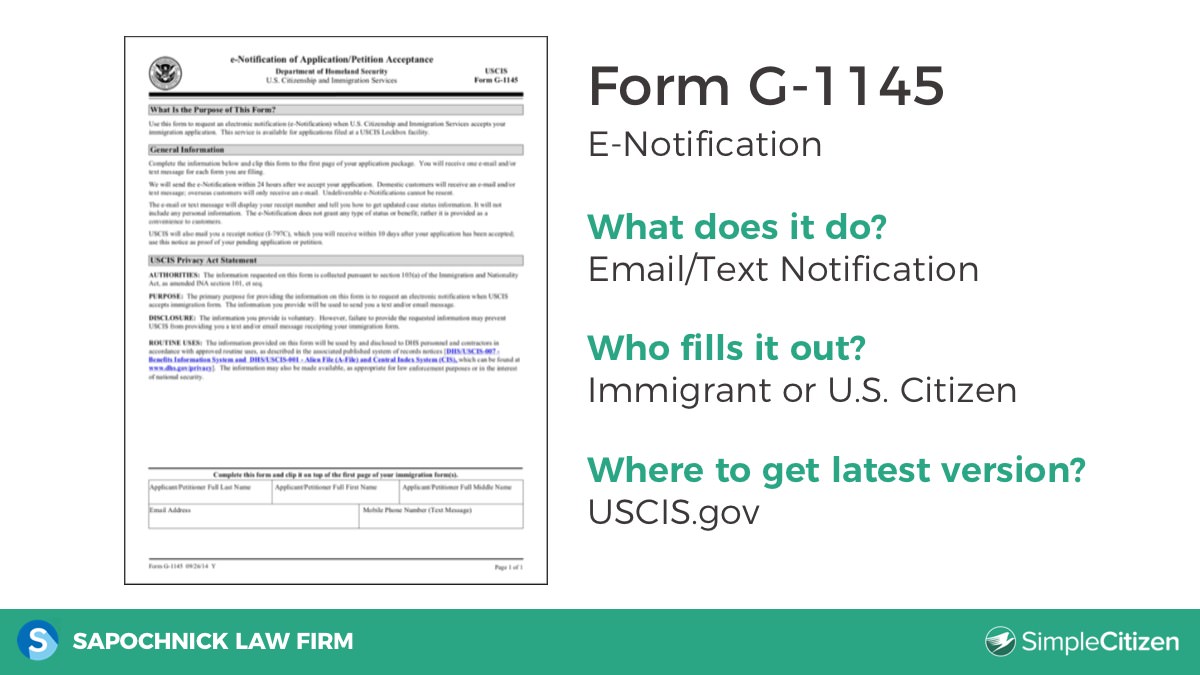
Matt: Okay so the first form that we include in the green card application is the form G-1145, so I’ll briefly talk about this, it is the email notification form, it is just a one-page form and it is so that you get email and text notification as your status changes and it is updated with the USCIS. So this could be filled out by anyone for any application that you are applying for, so if you are just sending in the form I-130 petition, you can fill out this form so you get updates, so that would be the US citizen filling out the form or if it is for the form I-485, then you can also fill out this form and include it with the form I-485 so then the immigrant will be filling it out. And you can get the latest form on USCIS.gov. That is where you will get all these latest form, when you are sending this form make sure you are sending in the most up-to-date form otherwise the USCIS will send it back and will say you need to fill it out with a new form.
Form I-130: Petition for Alien Relative
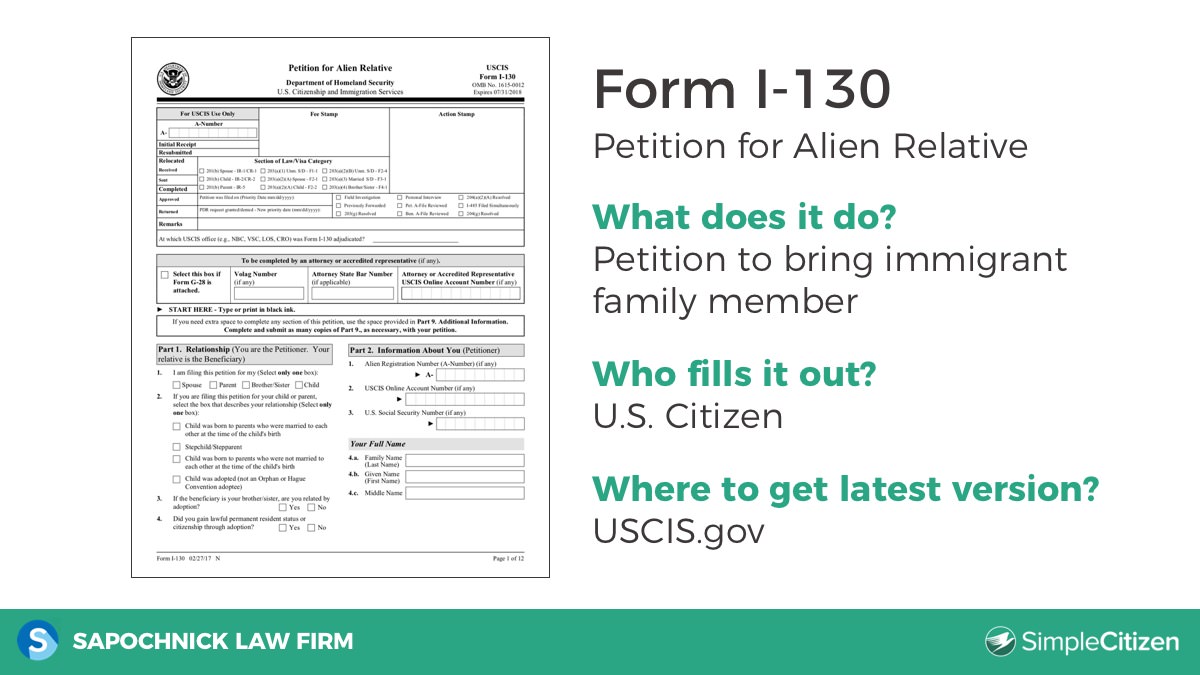
Matt: So the second form that is included in the green card application is the form I-130 which is the petition for an alien relative. So basically what that means is I am a US citizen, so my wife she is from Costa Rica, so if I were to fill out this form, it would mean that either she is residing in the US and I want her to remain here and be eligible to apply for a green card or she is living outside of the US and I want her to be able to come to the US and reside here permanently. So US citizens are filling this out and it is to petition whoever they would like to come to US, so if that is a sibling or a parent or a child, you need to fill out this form and say this is my immigrant relative whom I want to come to the US and you give some background information about yourself, about the US citizen and then in the end you sign it and send it in. So Jacob talked about the adjustment of status application while you are based here in the US, if you are based in US and you fall in that first preference category like spouse of a US citizen or parent of the US citizen then you fill the form I-130 together with all the other forms, you don’t need to fill the form I-130, wait for its approval and then submit all the other forms. But the way it works with the form I-130 if you send it in and then you have to wait with those preference we are showing before, you know if it is 7 years or 6 years or 14 months, you send in the form I-130 and you wait those 14 months and they assign you a priority date and so you continue to check the USCIS website and until that priority date is correct and we will show the URL for that website so you can continue to go to that website, so if my wife were to petition her mom who lives in Costa Rica currently, then we will wait until the form I-130 is approved and then once it is approved we will go through the rest of the process and because she falls into that first category, it will be pretty quick but if you were to petition her brother then it take those 13 years or whatever for the priority date to become current.
Jacob: and you know the form I-130 form is one of the most important documents in this whole family petition whether you do it for spouse or for you know sibling or a parent because the form I-130 sets the foundation for everything that goes afterwards. So if it is an immediate visa or for example for a spouse and they are in the US, obviously the form I-130 will be the main form and everything else will come with it, but any mistake on that form could kind of snowball on creating issues down the road. That is why it is important to do it correctly, make sure that the right category is checked and also make sure that when the form is completed, there is an indication whether the person is in the US or outside of the US because if the person is in the US and the form is filled as if they are not in the US, it could create all kind complications down the road. It is very important for this form to complete correctly because every form has to be done correctly but the form I-130 and the form I-485 that we are going to talk about soon are the most important forms and must be done very carefully.
Matt: Thanks Jacob, okay, so here is the supporting documents for the form I-130 if you need including in the addendums or providing additional information, you want to include that right after the form. So you are required to submit five years of address history, if you have moved around a lot in that five years then there isn’t enough space on the actual form to fill out that information. So the way our software does it is that we create an addendum and we create a table that shows all of the additional addresses and the dates for those addresses. You can also provide it in the additional information at the very end of the form, you should also include the petitioner’s birth certificate, so that the petitioner is a US citizen and they are called a petitioner because this is a petition and there is a petition in it. So they should submit their birth certificate to show that they are eligible to bring their relative to the US because they are US citizens. They should also submit their passport and sometimes people don’t have a birth certificate and so I don’t know, Jacob do you know if the USCIS will only accept the passport or do they need the birth certificate?
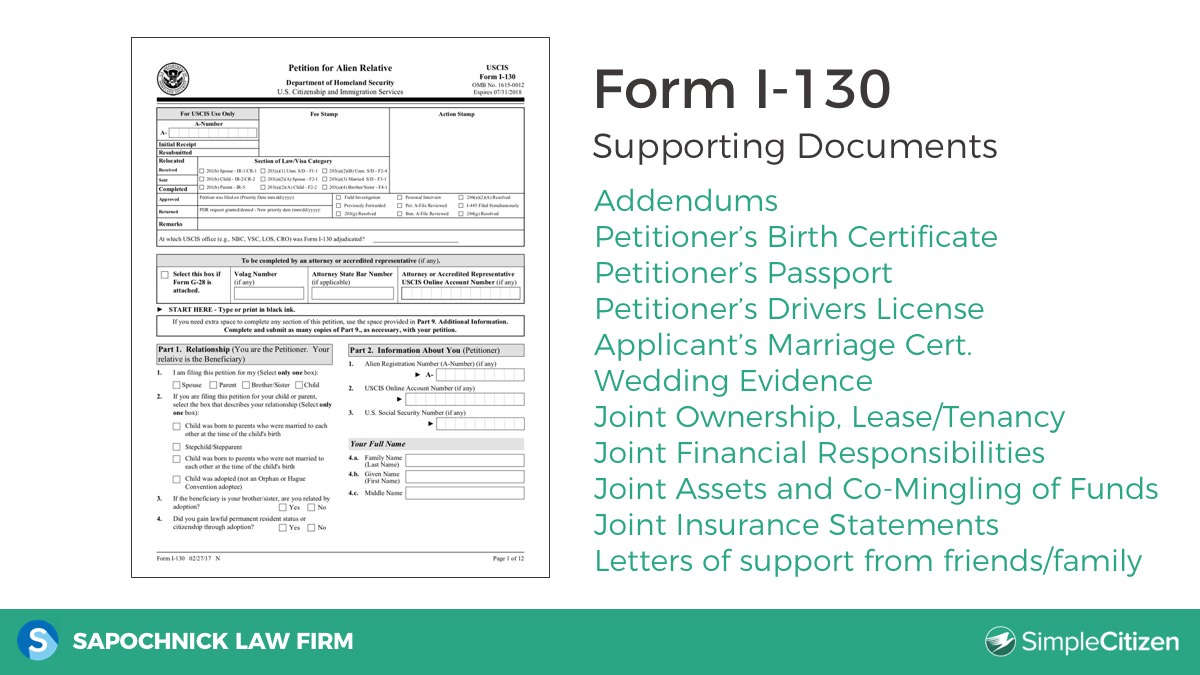
Jacob: So typically in family petitions, they want to see the birth certificate and it is important to try to get it. Now there are some request for evidence that we have been seeing that they had issues with the kind of birth certificates that the applicants are providing and then I guess we have to deal with them case by case basis but it is important to have a birth certificate. They won’t process the file with just the passport.
Matt: So of this list, what would you say is absolutely required and what would you say just adds to the case and makes it request for evidence?
Jacob: So birth certificates are a must, a passport is a must, we don’t need the driver license and marriage certificate is a must, we don’t necessarily need evidence of the wedding at the early stages, we don’t need evidence of joint ownership and lease, all financial support, you can do it in the beginning but it is not a must, they won’t deny the case if you don’t have it. Joint asset and co-mingling is not required just submit all of it in the beginning but you need to have the documents for the support document but here if you have those documents handy, you can provide kind of like a summary of those documents but it is not necessary. The must is the birth certificate, the marriage certificate, the passport and the information on the form, that is key.
Matt: Great and then the additional documents just add to the case.
Form I-130A: Supplemental Info for Spouse

Matt: Okay, so the form I-130A, this is a new form and it is if you are married to a US citizen then you fill out this form, it is only for spouses of US citizens and it is basically to get some background information on the spouse where their physical address, where they’ve lived in the past and it is a short form and it is just adding to the form I-130 so the immigrant is the person filling this out and they should sign it and all of the supporting documents should be their document. So you include their birth certificate, their passport, and US visa, their I-94 and if they have employment authorization you can include that too. But for the documents they must include Jacob are the birth certificate and the passport and the visa, right.

Jacob: Correct.
Matt: And the I-94.
Jacob: Of course yeah, to show proof that they entered legally.
Form I-485: Application to Register Permanent Residence or Adjust Status
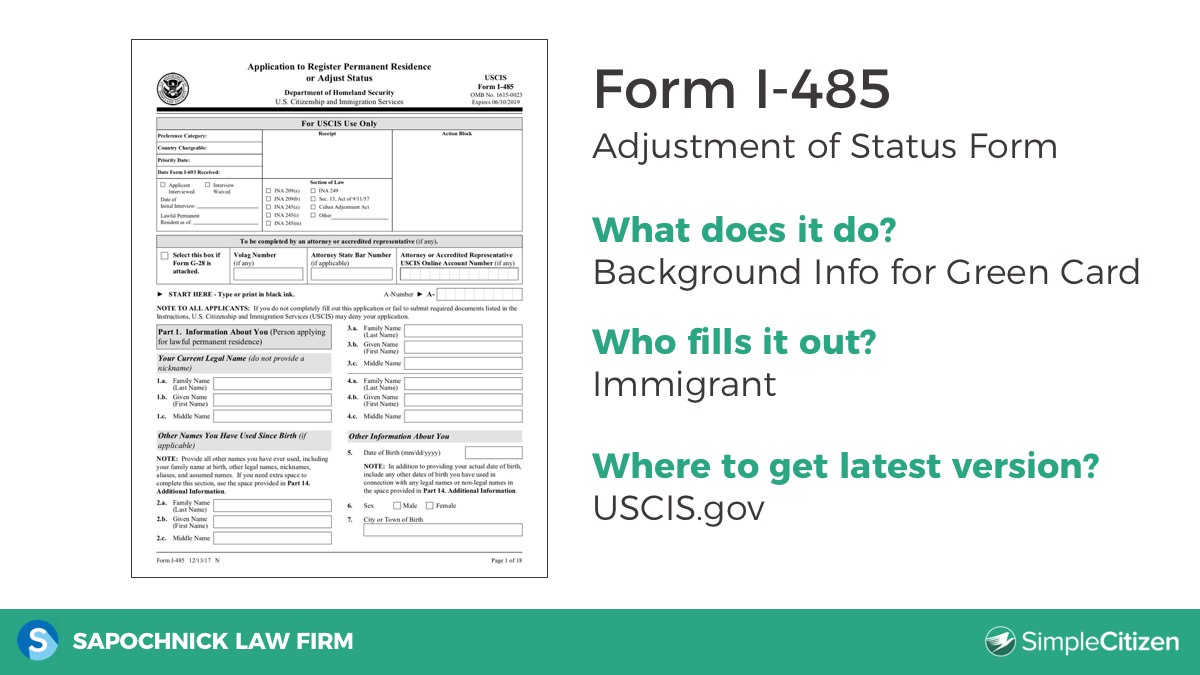
Matt: Great, okay here is the form I-485, this is a form that is allowing you to apply for a green card. So you first admit the form I-130, the I-130A, those are the petitions, then the petitions are approved then that is when you submit the form I-485, this is if you are currently living in the United States. If you are outside of United States, then you need to go through a process called consular processing. We are not going to talk much about consular processing but if you have questions at the end of the webinar, we are happy to address some of the questions about consular processing. So the form I-485 is to get background information on the immigrant so that the USCIS which is the US Department of Immigration and Citizenship sees that the immigrant is eligible for a green card. So again make sure have the most up to date form and you can find that on USCIS.gov.
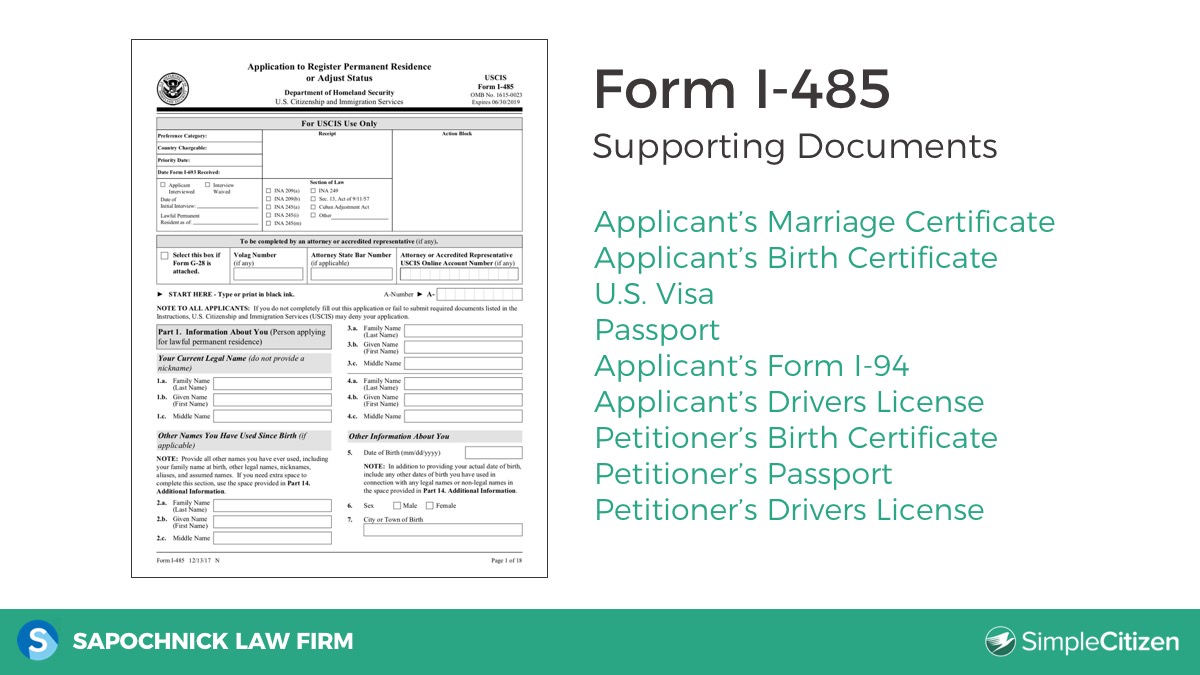
Matt: Here are the supporting documents, again the marriage certificate, the birth certificate, the US visa for the immigrants, the passport, the I-94 which might take the form shows you have valid entry into the United State and you are eligible, you are allowed to stay until a certain day, you can access that on the department of state website and then you can add some of these additional documents that aren’t necessary like the applicant’s driver’s license, the petitioner’s drivers license, the petitioner should also include their birth certificate and their passport.
Jacob: And one important document that should come on the form I-485 and yet it is not applicable to all people to file this but for example let’s say he had a criminal background and he had a conviction or something and there is a question that ask that, so it is important to add that with your form I-485. Any criminal resolution should be added to your file at time of filing.
Matt: Great, thanks Jacob, like Jacob said there is a series of questions that determines eligibility, some of those questions are “have you overstayed?”, or “have you violated the terms of your immigrant status?” and if you “have overstayed your visa?”, you have violated those terms, you have to check “yes” and then you give some backgrounds, so the way that our software does this is that you check yes and then you give a brief explanation, for example, “I overstayed my visa because I was visiting the US and turns out I met my spouse we fell in love and we got married.” In a spousal petition, these things are forgiven instantly and it isn’t that big of a deal if you work without authorization, or if you have overstayed your I-94 until date because you are married to a US citizen. In other application, it is a different story right Jacob?
Jacob: So it is you know it is one of those things where it is important to be kind of focused on a particular case, so in this case you know let’s give an example of somebody who was filing and they have so they have documents that aren’t clear, to kind of provide an explanation as to why is that matching to the common document they want to see.
Matt: Great and the way our software does that like I said previously, we create addendums and we give the descriptions and some of the evidence. There is also additional information where you can provide some of that evidence in details there. The next form is the form I-765.
Form I-765: Application for Employment Authorization
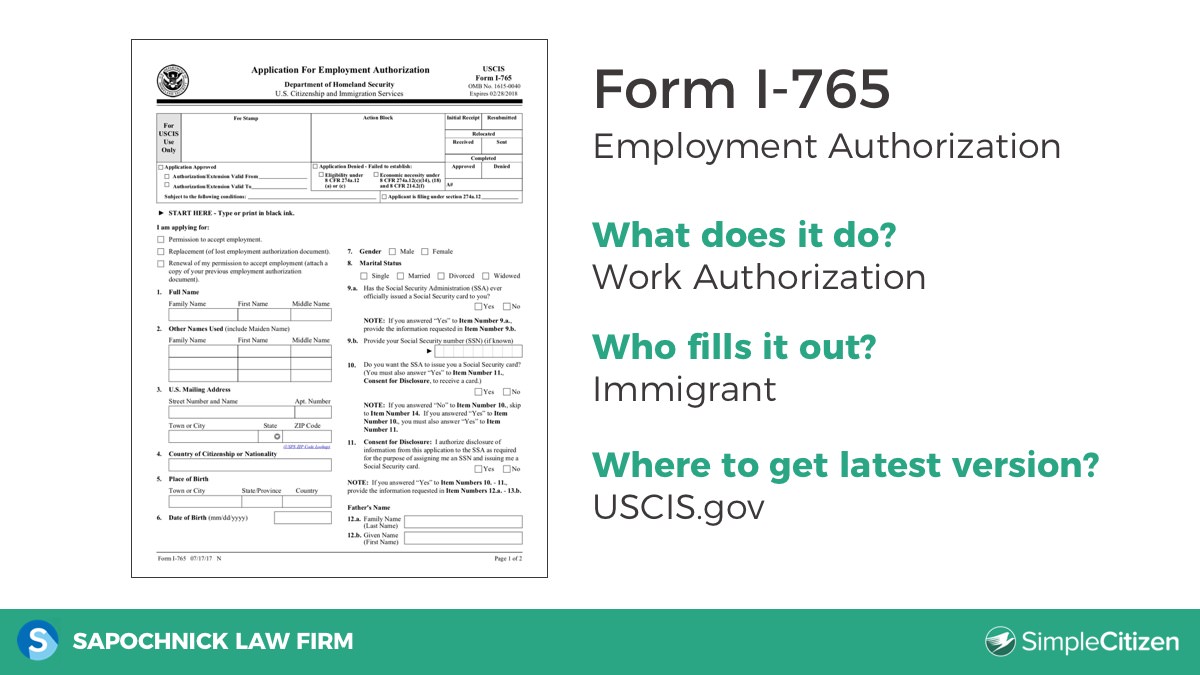
Matt: The form I-765 is the employment authorization form so if you want to be eligible to work in the US, then you should fill out this form. It asks some basic information if you have applied for a EAD or employment authorization document, if you have applied for one before, it asks your country of citizenship, where you are born, if you are single, it ask what eligibility you are applying under and then a new thing that they just recently added is it ask for your social security number and if you have been issued a social security number previously, if you have not this form will also allow you to be issued a social security number and card.
Jacob: Right and actually one more thing Matt, so it typically takes about 90 days to get that card on average processing. So, typically people file this, they file it at the same time as the other documents however, sometimes people need to get it sooner for whatever reason and so there are reasons like emergency that people can try to expedite the issue of the card and it is case by case basis and it is something that it is possible to do after filing.
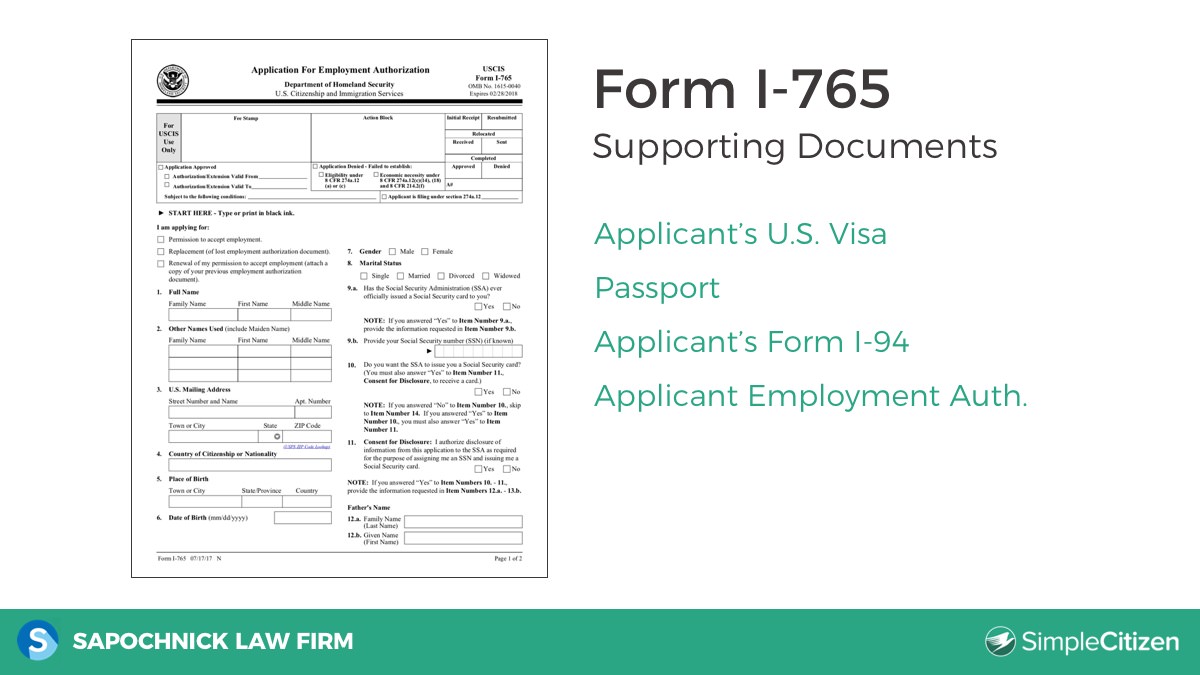
Matt: Great, thanks Jacob. So the supporting documents similar to ones in previous forms, the applicant US visa, their passport, their I-94 and if they have had a EAD previously, they should include that here.
Form I-131: Application for Travel Document
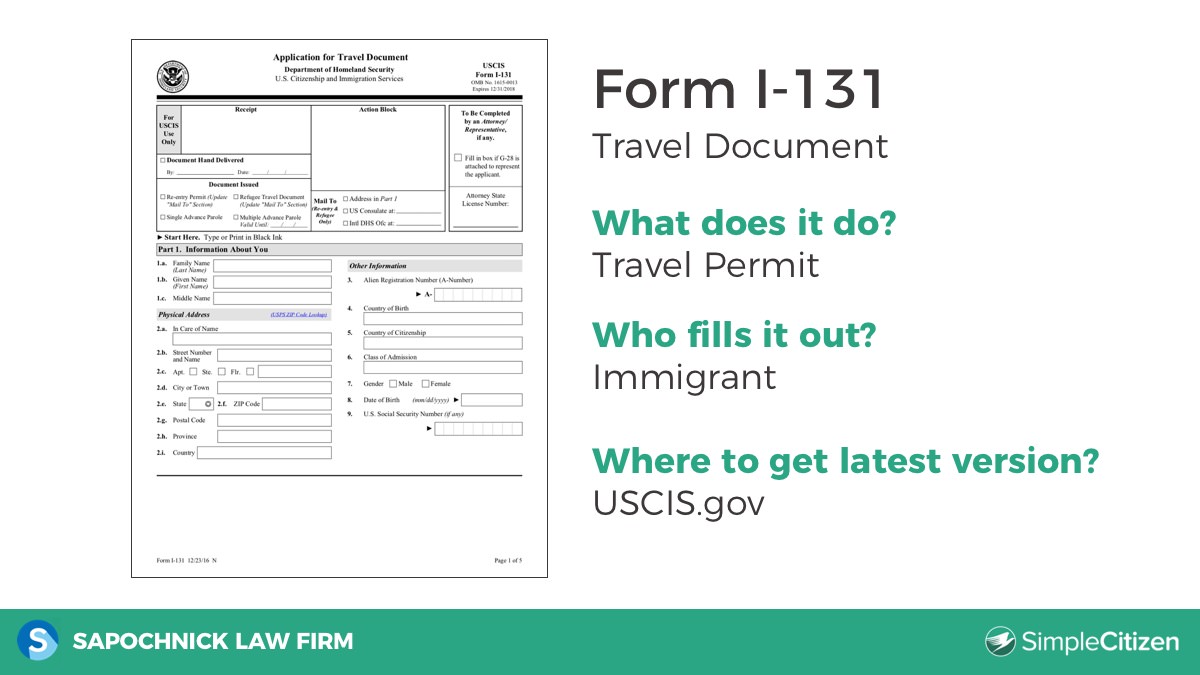
Matt: Okay, the next document is the form I-131, so this is the travel permit and it also serves a few other purposes, it could be if you need to apply for advance parole, it could be that. If you need to apply for the re-entry permit it could be that as well. For the green card purpose it is the advance parole document. So what that means is while you are waiting for your green card to process, which currently depending on where you live can take around a year, you can fill out this form and you are eligible to travel once you get the EAD card, so it will be employment authorization card but then on the bottom it will say valid for advance parole and then when you leave and reenter the country you can use that document along with your passport, so you no longer need to use a visa because your status is “form I-485 pending”, which basically means you are waiting for the green card. Keep in mind when you travel with the EAD advance parole document then you will most likely go through extra secondary inspection. That is correct, right Jacob?
Jacob: Yeah and one thing is I am going to say Matt is that while this is a documented issue and people have it. Immigration are always in the position that it is not a guarantee for re-entry, so just like you said they will be pulled over for secondary inspection, they will be asking them questions that why did you go? And so of course in most cases they will let the person in but it is not a guarantee, so I will always tell people don’t travel unless you have to because if there is a reason for them to suspect something is going on and they don’t have to let you in. So we always say keep it for necessary travel only as possible.

Matt: Great thanks Jacob. For supporting documents, the applicant’s (so when I say applicants here I am referring to the immigrants), the applicant’s U.S visa, their passport, their I-94 and their employment authorization card if they have had it previously.
Form I-693: Application for Travel Document
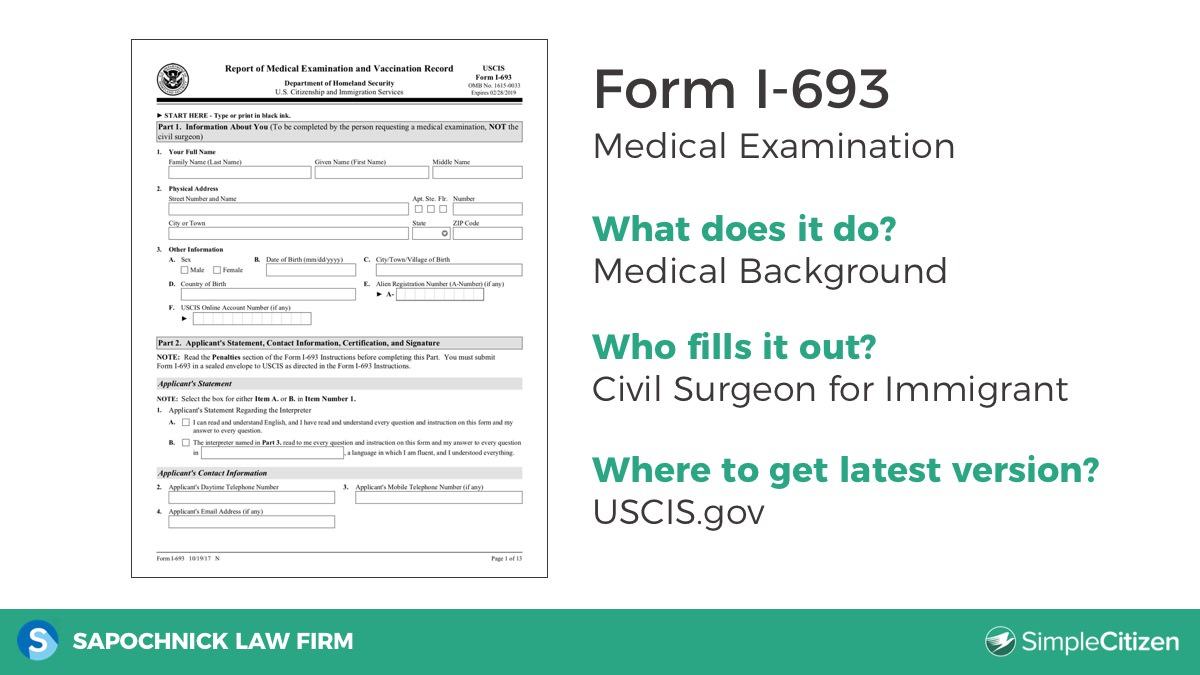
Matt: The form I-693 is the medical examination form, it is basically giving medical background on the immigrant, you have to go to a specific doctor that you can find on the USCIS website and they call it a civil surgeon and you will go to this doctor appointment, they will ask about which vaccinations you have received, some of your medical background and then they will fill this out. They will put it in a sealed envelope. You will have to go to two different appointments and you might actually get several vaccinations and they will put in the sealed envelope and do not open this envelope and you will include that envelope in the initial package you sent to the USCIS or you can send it a little bit later or you can bring it to your interview, keep in mind that the sealed envelope is valid only for a year and so it needs to be valid up until the time of the interview. So as green card processing is currently taking about a year, you might want to send this in a little bit after sending in all your documents or bring it in to your interview.
Jacob: That is good, also it is important to go only through a licensed USCIS agent because if you go to an alternative option, it may delay process.
Putting the Application Together
Matt: Great thanks Jacob. So now we are going to show what an actual green card looks like and how you should prepare and put it together. So I am going to open up the webcam now. Okay so I actually have mine and my wife’s green card application here. This is what it looks like.

Matt: So this is how we prepare it, you can see right here we have a cover letter and it tells the USCIS officer all of the documents and forms that are included in this application. This cover letter is two pages, it is addressed to the USCIS officer and we are sending it to the lockbox in Chicago, so we have the address right there. The way that we do it here at SimpleCitizen is we hole punch right where we put the fasteners in here. So you can see it is pretty thick and this is I’d say a medium sized green card and so this is the best way that we found to prepare them, is if you use Arco fasteners. You can also use folders and you can hole punch that, you can see we have all the different forms here, so you can see here is the form G-1145, we also have the form I-130 right here and then we have all the supporting documents that go with it. So the form I-130 has all been filled out by the software, the nice thing about using SimpleCitizen is there is a lot of duplicate information in this forms and so when you use SimpleCitizen, it fills everything out instantly and makes the process much quicker and then you don’t have to fax things in, you can actually just take a picture with your phone for your supporting documents and you can upload that to the software and we will print it out and send it to you. So you can see I have included my birth certificate right here, I have my passport and all the other supporting documents that we have talked about. So in here we have also included some of our marriage evidence so you can see right here we have our joint insurance document with GEICO, we also included our lease, we also included a bunch of photos, there is a photo from my wedding and just to show the USCIS officer that our marriage is legitimate. After the I-130, we have the I-130A, you can see right there, we filled that out, added the supporting documents and then we have the form I-485 with all the supporting documents and then we have the form I-864 which is the affidavit of support, it is the document that you use to show, to get a financial sponsor and so a financial sponsor should make a 125 percent of the federal poverty line, which for two people it is about $21,000 and to show that income they should include paystubs, tax documents, W2’s, all of that. So we also include an envelope with the address where you should send in the green card form or whatever form you are filing and we include a sample check. So that will show you exactly what the check should look like, US department of homeland security, the amount, the immigrant’s full name with the form you are using and then you should include the passport photo, so we include the instructions all of that, then we will also include a package like this that explains very clearly how you should do everything.
Jacob: And what is important about doing this way is that the immigration officers are bombarded with thousands of applications and if they get something clear and organized in that way, it makes their life so much easier. You know we meet, I go to conferences 6-7 times a year and we will meet our partners in the immigration service and they keep telling us listen, when we get a package that is organized, that brightens our day because they know it is going to be faster for them to find what they need, process the file and move on to the next one which is going to be much messier and less organized. So yeah following a clear path with organized documents in that kind of order, it is going to increase the chance of approval tremendously.
Matt: Thanks Jacob, so quickly we are going to go over the last couple of slides that we have here that tell you how to pay the government fees, what the cost is and then how we do an attorney review here at SimpleCitizen and then also why you should mail it and then we will finish up with the Q&A. So I am going to screen share again.
Green Card Application Fee
Matt: Okay, so here are the fees for the different forms, the form I-130 is $535, the form I-485 is $1,140 with the I-485 depending on your age, you need to pay a biometric service fee of $85, when you put all of those forms together, the form I-765 and the form I-131 fees is waived. Here is about how the check should look, you should put US department of Homeland Security, the amount, the immigrant’s name and the form in the memo line.
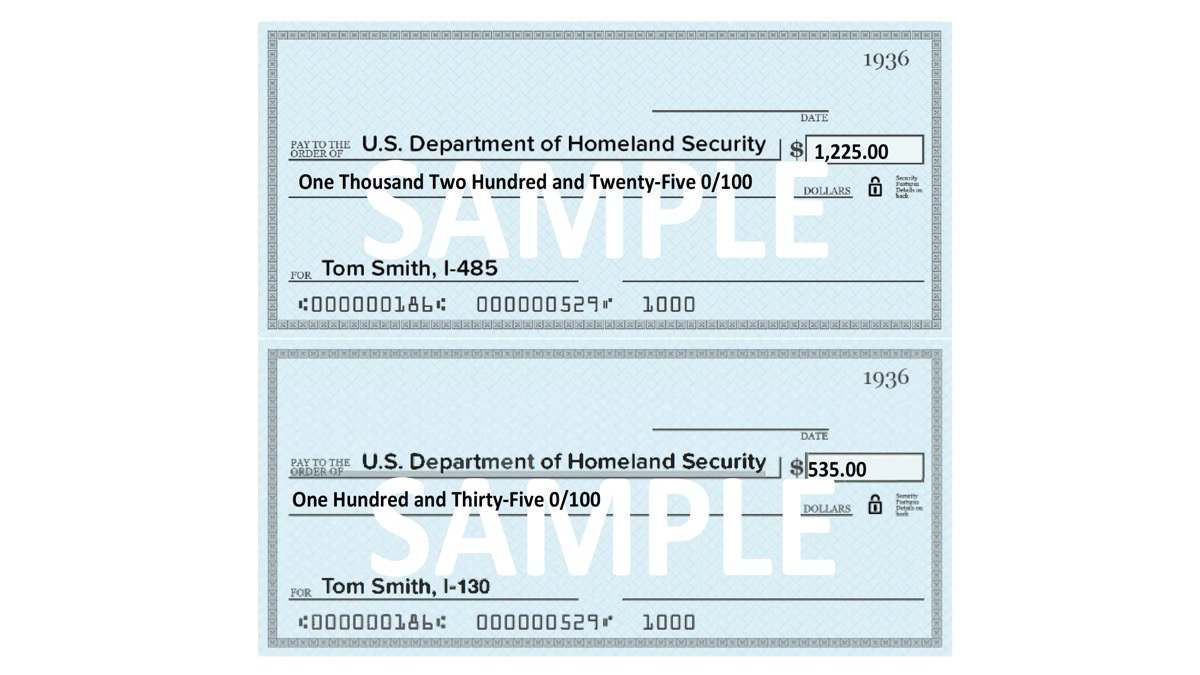
Matt: Briefly we will talk about the fee waivers, if you fall under the federal poverty line and you have a means-tested benefit like food stamps or something like that or you are experiencing financial hardship then you are able to submit a fee waiver, so you don’t have to pay some of the USCIS fees.
Immigration Attorney Review
Matt: So the way that we do here at the SimpleCitizen, we charge $250 for preparing the whole application (what the software does) and then we charge an extra $100 if the customer wants an attorney review and basically what an attorney review does is the application is reviewed by a professional immigration attorney, at Jacob’s office actually and the feature and options is available for every application through SimpleCitizen. The steps ensure that the application is a 100% correct and it is ready to be sent to the USCIS. So we have processed over 3000 applications and we have a 100% approval by the USCIS, we have never had a rejection and I think when people fill out the application on their own, it is about a 30% chance of rejection or request for evidence. So it is good to get through an Attorney and have it reviewed.
Mailing the Application

Matt: So to mail the green card application, if you are filing everything at the same thing, you will file it concurrently like we talk about in the beginning, you will send it into lock box in Chicago, if you are just submitting the form I-130, you will either send it to Chicago or you will send it to Phoenix and that is based on your address. If you just go to the form I-130 website, you will know it shows where you are living and where you should send it. So here is the URL you should use to check processing time and the visa bulletin through the USCIS, so if I click right here, I can check the most recent visa bulletin for February 2018 and this will allow me to see when the priority date is being processed. So if I look right here, if I am F-1 category, then if I have a priority date of January 1st 2012, I can start the rest of the application. If I click here, I can see how long the processing times on mine and my wife’s application, I will go to something like city of Utah, I will click the field office, will submit the form I-485 so they are processing from March 13, 2017. So I have to wait about a year.
USCIS Case Status Checker
Matt: And then we have another URL here for a case status tracker, so this is on our website and you can put your USCIS case number that they assigned and send to you in the mail and it would give any update to your application. So those can be text and email updates to let you know it has been processed and they are ready to schedule an interview. So I think now Jacob if you don’t have anything to add, we will open it up to Q&A.
Jacob: I just want to add one thing, when you are mentioning about the percentage who are not going through the software and Attorney review, it is not just about the rejection, sometimes you know when you put a wrong information, it stays there you know years later when they find out and you know they see that information and you have try to explain why it happened. It can actually backfire, so it is not just about getting rejected but it also making sure that whatever you are giving the government is correct because it can be used against you one day and if you say I didn’t mean to do it, it may not be enough of an excuse. So we are looking both from a safety process and we are also making sure that whoever is going through the process is going to secure for the long term.
Webinar Questions & Answers
Matt: First we have Rebeca’s questions;
Question: What immigration fee do I need to submit to that fee while I am applying for my spouse who is an F1 student visa holder and living in the United States?
Answer: So Rebecca you are able to file concurrently so you are able to submit all of the forms at the same time, so you will have to pay the form I-130 fee as well as the form I-485 fee, so it ends up being around $1700 and your situation is exactly what SimpleCitizen software was designed for. So if you want help doing it, feel free to go on to start.simplecitizen.com and we can help you through the whole process.
Jacob: We have a question from Whitney;
Question: Did you say there is another way to get the I-94?
Answer: Yes, so there is a website by CDP and I guess we can post it in the comment where you can actually log in and type your passport number and you can print the I-94 so there is a way to do it.
Matt: Great and that URL is here.
Question: Can a spousal reside outside of the US visit while the petition is pending?
Answer: Yeah absolutely, so if you are doing the petition for a consulate which means you are not doing it concurrently, then while that form I-130 is pending, the spouse can come back and forth as a tourist and there is no issue with that.
Question: What if the petitioner don’t have a passport?
Answer: The petitioner does not need to have a passport; it is only the beneficiary that needs it. That is a good question, the petitioner just need to have a US birth certificate and that is it, they don’t need to have a passport. US citizen doesn’t have a passport to file for their spouse.
Question: Hillary, I got married and want my green card to come with my last name changed, should I fill out the form with my new name?
Answer: So there are two ways that we see it, so you can do it already with the married name, now that you have your new marriage certificate but we kind of like my personal thing that I recommend often is that you keep your name before marriage, the one on your passport for the first green card because the first green card is going to be issued for two years only and as you get ready for the renewal of your conditions two years later, you will have enough time to update your new married name and the reason we are saying that is because all your documents will have your previous name and it may cause some delays, so unless you really have to do it, I would recommend to do it only at the renewal of the second green card.
Question: When applying for my green card, do I need to send my medicals along with the forms away from the interview?
Answer: So Matt we talked about it during that presentation, you can do it with application again it is good for a year and so you know typically everything should be done in a year or you can bring it with you to the interview, so it is really up to you but I mean we always recommend to send it with the case if you can and that just makes things much simpler but you can also bring it to the interview, there is not preference here.
Question: can you give us more info about the interview process?
Answer: Whitney, we will probably do another webinar just focusing on the interview, the interview itself is a whole hour of discussion but I can tell you one thing is that any documents that you collect together after we file this package or we talked about it, keep it in the box, put your bills in there, put your pictures, put your any joint documents, put them in the box, you can have all these joint documents for the interview but I think we will do one Matt maybe in a month or so just focus on the interview because I think people want to know what is happening behind those closed doors and we will go over the process, we will give some insider tips.
Jacob: Jamie, Question: my husband and I are married for 10 months when we apply for green card, do we get two or ten-year green card?
Answer: Alright any marriage less than 2 years is going to be a conditional two-year green card, so you will get a conditioner green card for only two years because your marriage is less than two years.
Jacob: How about if we post an email address maybe like a general email address where anybody who wants to ask questions for the next 24 hours, we will be sure to answer them because they came on our webinar, so maybe let me see.
Matt: Great and we are doing it again on Tuesday and so if anyone missed the webinar or missed the part of the webinar, they can hop on again on Tuesday and Sam will shoot an email in the chat, it will be support@simplecitizen.com. So if anyone has any question or need anything, feel free to email support@simplecitizen.com and we are happy to answer your questions.
Jacob: Well I just want to mention one thing, I am going to say that things are going to get more complicated in the next few months with the government and so SimpleCitizen and our collaboration will continue to improve the tools and the supports we give our customers because we want to continue the 100% approval rate because trust me everybody out there who is not going to use our system are going to be seeing much more denials and delays and we want to fight that. So stick with us and be successful.
Matt: Great thanks Jacob and thanks everyone for joining us and if you want to join us again on Tuesday thanks.
Jacob: Perfect I will be there.
End of Webinar Transcript
Get Started
Online with SimpleCitizen Includes:
Immigration Attorney Review
Form I-485 | Adjustment of Status
Form I-130 | Alien Petition
Form I-131 | Travel Permit
Form I-765 | Employment Authorization
Form I-864 | Financial Sponsor
Form I-693 | Medical Examination
Form G-1145 | E-Notification
+ All Supporting Documents
+ Printing & Shipping
Helpful Links:
The Ultimate Guide on How to Get a Green Card
SimpleCitizen.com
Sapochnick Law Firm – U.S. Immigration Law
